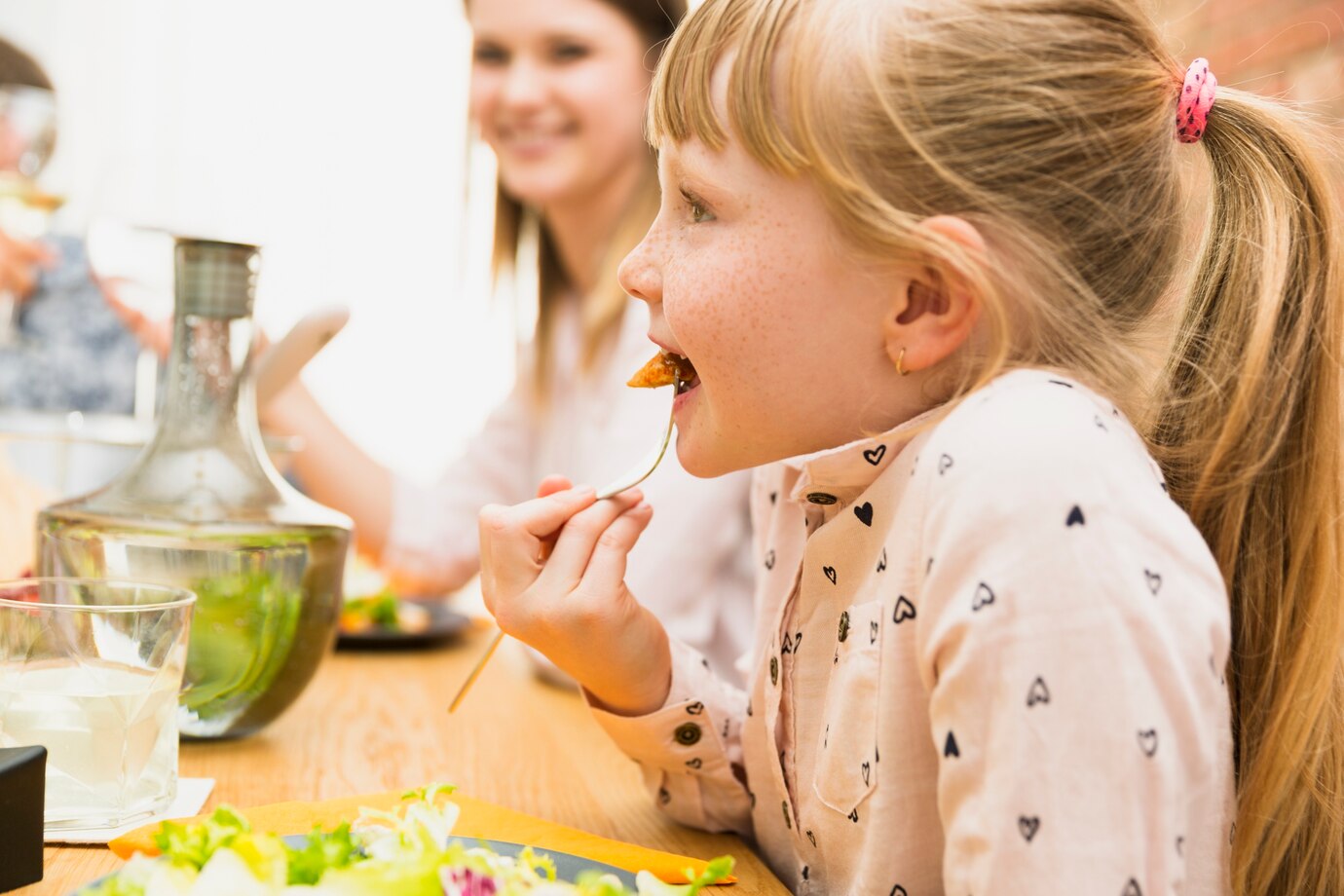Top Fun Eating Games For Picky Children

Dr Nick Fuller
Leading Obesity Expert at the University of Sydney and founder of Interval Weight Loss.

Most of the time, getting picky kids to eat can feel like an impossible task. But what if you could make mealtimes more fun and less about fuss? That’s where eating games come in.
Experiential learning—where kids learn through hands-on activities like cooking, taste-testing, and games—can significantly improve their knowledge and behaviours around food. Studies have found that these activities help even the fussiest eaters try new foods and develop healthier eating habits.
So, let’s dive into some creative eating games that can turn dinner time into playtime and encourage kids to give broccoli a go.
Make Mealtimes Fun with Creative Strategies
Mealtime struggles with picky eaters? Find a fun solution today! Dr Nick Fuller’s Healthy Parents, Healthy Kids offers practical advice on using creative strategies to make mealtimes more enjoyable. Learn how to turn even the most stressful mealtimes into a playful experience that encourages your kids to try new foods.
Get your copy of Healthy Parents, Healthy Kids now and make mealtime fun for the whole family!
20 Fun Eating Games For Picky Children
Fun and creative eating games can turn picky eating into an exciting adventure. Below are some games that will encourage your child to explore new foods and make every meal a little more fun.
Flavour Wheel Spin
Introduce your child to new tastes in a fun, pressure-free way with this simple game. Focusing on flavours helps kids feel more comfortable exploring different foods while keeping the experience playful and engaging.
- What You’ll Need: A ‘flavour wheel’ featuring categories like sweet, salty, sour, and bitter, along with a selection of foods that fit each category.
- How to Play: Spin the wheel and let your child pick a food from the category it lands on. Encourage them to describe the taste or compare it to something they already know. It’s a fun way to expand their palate and make trying new foods an adventure!
Mystery Box Taste Test
Transform trying new foods into a thrilling game of discovery. This activity builds curiosity and excitement around food, making it less intimidating and more enjoyable.
- What You’ll Need: A box or bag to hide the foods, along with a variety of small, bite-sized foods to taste.
- How to Play: Place different foods in the box and have your child try one without looking. Ask them to guess what it is based on taste, texture, or smell. Reward correct guesses or praise their willingness to explore something new.
Chef for a Day
Empower your child to take charge in the kitchen and discover the joy of cooking. This hands-on experience can build their confidence and make them more open to trying what they’ve helped create.
- What You’ll Need: Simple ingredients, child-safe kitchen tools, and an easy recipe your child can help prepare.
- How to Play: Let your child wear a chef’s hat, choose a recipe, and take the lead in preparing it (with supervision). The pride they’ll feel in creating their dish might just make them excited to eat it too!
Colourful Plate Challenge
Turn mealtime into a colourful adventure with this simple but effective game. Adding variety to their plate makes food more exciting while encouraging balanced eating.
- What You’ll Need: A selection of fruits, vegetables, and other colourful foods.
- How to Play: Challenge your child to create the most colourful plate possible. They must include at least one food from each colour and try a bite of each. Celebrate their creativity and willingness to try new things.
Food Art Fun
Combine creativity with mealtime to make food irresistible. Kids are more likely to try foods when they’re part of a fun, hands-on activity like food art.
- What You’ll Need: A variety of fruits, veggies, and other foods that can be easily arranged into shapes or pictures.
- How to Play: Encourage your child to create animals, faces, or other fun designs with their food. Once the masterpiece is complete, they can ‘eat the art’, making the experience both creative and delicious!
Storytime Meal
Bring imagination to the table with story-driven meals. Linking food to a fun narrative can help kids view mealtime as an exciting adventure.
- What You’ll Need: A little creativity and the food you’re serving.
- How to Play: Turn foods into characters or objects in a story. For example, a broccoli floret could be a tree, or spaghetti might be a magic rope. Encourage your child to ‘help’ the characters by eating them.
Food Memory Game
Improve your child’s memory and food familiarity with this quick and engaging game. It’s a great way to make new foods memorable and less intimidating.
- What You’ll Need: A variety of small food items and a cloth to cover them.
- How to Play: Lay out the foods, cover them, and let your child observe for a few seconds. Remove the cloth and ask them to recall what they saw. As a bonus, they can taste-test any foods they remember.
Create a Food Alphabet
Turn the alphabet into a food adventure while building your child’s interest in trying new things. This game adds an educational twist to exploring different foods.
- What You’ll Need: Foods that represent as many letters of the alphabet as possible.
- How to Play: Have your child go through the alphabet and find foods that match each letter. You can provide suggestions or let them get creative. For every letter they complete, they must try at least one new food.
Food Group Sorting
Teach your child about balanced eating while they play. This game introduces food groups in a fun, interactive way and encourages variety on their plate.
- What You’ll Need: A variety of foods representing different groups (fruits, vegetables, proteins, grains, and dairy).
- How to Play: Ask your child to sort the foods into their correct categories. Once sorted, challenge them to try at least one food from each group.
Marshmallow Tower
Combine building and eating in this playful activity. This game encourages creativity while making new foods less intimidating.
- What You’ll Need: Marshmallows, toothpicks, and additional foods like fruits or veggies to use as ‘blocks’.
- How to Play: Let your child build the tallest tower they can using the materials. Afterwards, they can ‘demolish’ the tower by eating the pieces, including the healthy ones.
Mystery Produce
Turn trying new fruits and vegetables into a guessing game that sparks curiosity and exploration. This activity helps your child feel more at ease with unfamiliar foods.
- What You’ll Need: A new fruit or vegetable each round and a blindfold (optional).
- How to Play: Present the mystery item and encourage your child to guess what it is by touching, smelling, or tasting it. Once they guess correctly, talk about its name, where it grows, and why it’s nutritious.
Spaghetti Challenge
Make mealtime a playful competition with this spaghetti-inspired game. Adding a fun twist to eating can make kids more willing to try different toppings and textures.
- What You’ll Need: Cooked spaghetti, forks, and a variety of toppings or sauces.
- How to Play: Set a timer and see who can eat their spaghetti the fastest without using their hands. Add extra fun by offering different sauces or toppings for your child to try during the challenge.
Tic Tac Toe
Combine strategy and snacking with this classic game featuring a food twist. This interactive approach can help kids feel more relaxed about trying new foods.
- What You’ll Need: A plate or board and small food items like grapes, carrot sticks, or crackers for game pieces.
- How to Play: Play Tic Tac Toe using the food pieces. The rule? Each time someone places a piece, they must eat one. By the end of the game, everyone had a taste of something new.
Cookie Cutting
Make food fun and inviting by turning it into playful shapes. This hands-on activity encourages kids to explore foods they might otherwise avoid.
- What You’ll Need: Cookie cutters and foods like sandwiches, fruits, or cheeses that are easy to cut into shapes.
- How to Play: Let your child cut their food into stars, hearts, or other fun shapes. They can eat the shapes they make, making it an enjoyable way to encourage interaction with food.
Eat Your Game Pieces
Turn board games into a food-tasting adventure. This game combines fun and trying new foods in a way that feels natural and pressure-free.
- What You’ll Need: A simple board game and small pieces of food to use as tokens (e.g., popcorn, cheese cubes, or fruit slices).
- How to Play: Replace regular game pieces with edible ones. Every time your child plays a piece or takes a turn, they have to eat the ‘game token’. It’s a playful and creative way to introduce a variety of foods.
Finger Painting with Pudding
Let your child unleash their inner artist with edible ‘paint’ while they explore new textures and flavours. This sensory activity makes food feel fun and approachable.
- What You’ll Need: Pudding or yoghurt in different colours and a large plate or tray.
- How to Play: Spread the pudding or yoghurt on the tray and let your child draw pictures or write letters with their fingers. Once they’re done, they can lick their fingers clean or taste their creations.
Food Knowledge Quiz
Transform mealtime into a trivia session by testing your child’s knowledge of foods. This activity is a great way to teach nutrition facts and spark curiosity about healthy eating.
- What You’ll Need: A list of food-related questions and a small treat or sticker as a reward.
- How to Play: Ask your child questions like ‘Which fruit has tiny seeds on the outside?’ or ‘What food is rich in calcium?’ They earn a point for each correct answer, and for added fun, let them try the foods mentioned in the quiz.
Food Labelling Activity
Help your child learn about nutrition labels while exploring their favourite snacks and meals. Understanding what’s in their food can encourage healthier choices without making it feel like a lecture.
- What You’ll Need: A few packaged foods with nutrition labels and a simple guide to explain terms like protein, sugar, or fibre.
- How to Play: Show your child how to read labels and discuss what each part means. Let them compare two items and decide which one they think is ‘better for the body.’ It’s a hands-on way to build awareness about food.
Theme Tasting Day
Bring a sense of adventure to the table with a themed food tasting. Whether it's ‘foods from the rainforest or ‘a day in Italy’, themed meals can spark curiosity and make trying new foods exciting.
- What You’ll Need: Foods that match your chosen theme, such as tropical fruits, international dishes, or foods of a specific colour.
- How to Play: Select a theme and prepare foods that fit it. Introduce each item with a fun fact—where it grows, how it's made, or its cultural significance. Encourage your child to describe the taste, guess the ingredients, or share which food they enjoyed most. Keep it relaxed and fun to make mealtime an adventure.
Veggie Guessing Bag
Turn exploring vegetables into a tactile guessing game. This activity helps kids become familiar with different vegetables without pressure to eat them immediately.
- What You’ll Need: A cloth bag or box and a variety of vegetables with unique shapes and textures.
- How to Play: Place the vegetables in the bag and let your child feel them without looking. They can guess what each one is based on its shape or texture. Afterwards, show them the vegetables, and if they’re ready, invite them to taste a small piece.
For more fun game ideas that can turn picky eating into playful adventures, check out this article about the top engaging mealtime games for picky eaters.
Final Thoughts
Mealtimes with picky eaters don’t have to be a struggle. By turning food into a game, you can create a fun, stress-free environment that encourages your child to explore new tastes and textures. These activities make eating an adventure for the whole family. Give them a try and watch mealtimes transform into moments of joy and discovery.
Keep on top of things with expert tips, top strategies, exclusive offers, and personalised support!
Meet Dr Nick Fuller
My Story
As a father, I know first-hand that raising healthy and happy children is tricky. Children are fussy, particularly at the end of the day when they are shattered. We also live in a society where companies seek to profit from what we feed our kids; incorrect and damaging advice is pushed on us and marketed towards our children, and we have no time.
But with these recipes and resources, you and your children can enjoy simple and well-founded food and lifestyle choices for lifelong health.

About Dr Nick Fuller
Dr Nick Fuller is the founder of Interval Weight Loss and is a leading obesity expert at the University of Sydney with a Ph.D. in Obesity Treatment. Dr Fuller is also the author of three best-selling books and his work been published in top ranked journals in the medical field, including JAMA, Lancet and American Journal of Clinical Nutrition.
